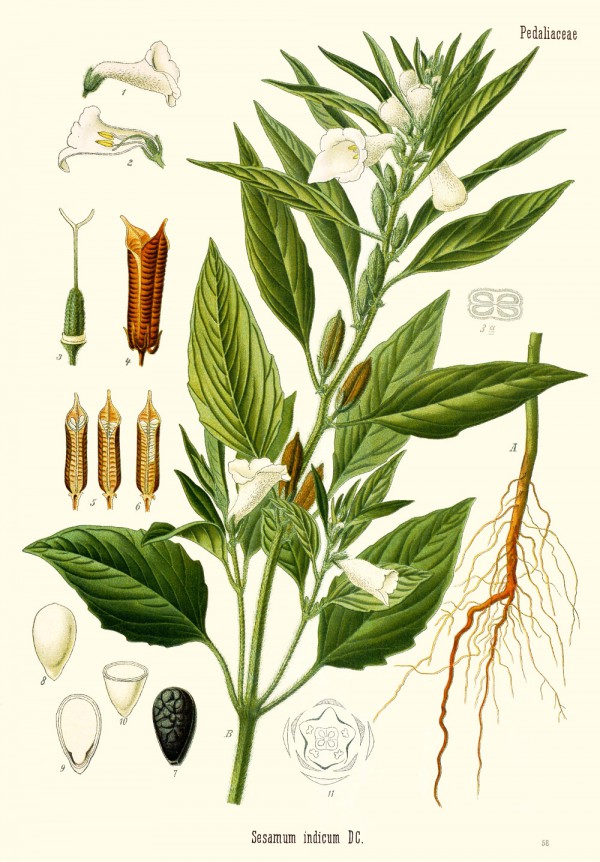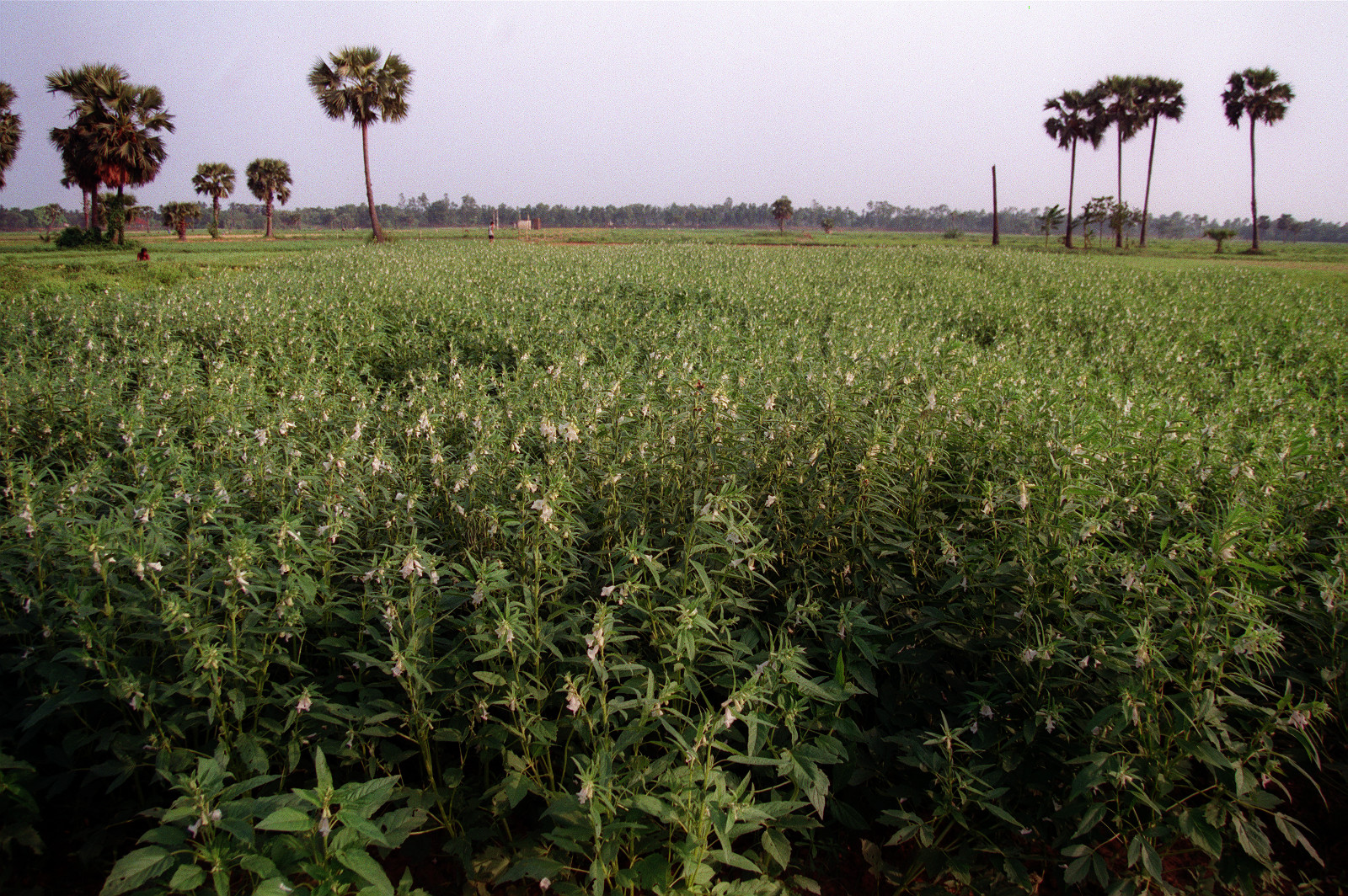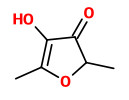Sesamum indicum L. - Pedaliaceae - sesame, Sesam
Annual herb, 10-120cm tall, possible origin India or tropic West Africa, widely cultivated in tropics , subtropics; branched and unbranched types are known; leaves linear-lanceolate; flowers bell-shaped, white or pink; fruit a capsule, up to 2.5cm long; seeds much smaller (2-3.5mm long), yellowish to pale brown.
„Aroma extract dilution analysis (AEDA) of an extract prepared from moderately roasted sesame (180 °C; 10 min) revealed 41 odour-active volatiles, 31 of which could be identified by comparison of their mass spectra, retention indices, odour quality and odour threshold with reference compounds. Of the 18 aroma compounds showing very high Flavour Dilution factors in the range of 128-2048, 10 compounds [2-furfurylthiol, 2-phenylethylthiol, 2-methoxyphenol, 4-hydroxy-2,5-dimethyl-3(2H)-furanone, 2-pentylpyridine, 2-ethyl-3,5-dimethylpyrazine, acetylpyrazine, (E,E)-2,4-decadienal, 2-acetyl-1-pyrroline and 4-vinyl-2-methoxy-phenol] were quantified by means of stable isotope dilution assays and their odour activity values (OAV; ratio of concentration to odour threshold) were calculated. On the basis of high OAVs in oil, especially 2-acetyl-1-pyrroline (roasty), 2-furfurylthiol (coffee-like), 2-phenylethylthiol (rubbery) and 4-hydroxy-2,5-dimethyl-3(2H)-furanone (caramel-like) were elucidated as important contributors to the overall roasty, sulphury odour of the crushed sesame material.“
[Odour-active compounds in moderately roasted sesame., Schieberle, P., Food Chemistry, 55(2), 1996, 145-152]
„The effect of roasting degree on the formation of volatile compounds in sesame seeds was investigated. Light- and deep-roasted sesame seed oils were steam distilled under reduced pressure, and volatiles from the distillate were separated by an adsorptive column method. The recoveries of total volatiles were 9726 and 2014 ppb from deep- and light-roasted oils, respectively. The relative amount of monoalkylpyrazines decreased in contrast to the increases of di- and trialkylpyrazines with increase in the degree of roasting. 1H-Pyrrole-2-carboxyaldehyde, the most abundant pyrrole, was the only volatile that decreased in deep-roasted oil. 4,5-Dimethylisothiazole, 4,5-dimethylthiazole, 2-propyl-4-methylthiazole, and 2-butyl-5-methylthiazole increased their relative amounts in deep-roasted oil. Hexanal, (E)-2-heptenal, and (E,E)-2,4-decadienal occurred in almost the same levels. Guaiacol and 2-furanmethanethiol increased from 32 to 321 ppb and from 6 to 40 ppb, respectively, in deep-roasted oil.“
[Quantitative comparison of volatile flavor compounds in deep-roasted and light-roasted sesame seed oil. Shimoda, M., Nakada, Y., Nakashima, M., Osajima, Y., Journal of agricultural and food chemistry, Vol.45(8), 1997, 3193-3196]
„Volatile compounds in the headspace gas of light and deep roasted sesame seed oil were analyzed by gas chromatography and gas chromatography-mass spectrometry. The present method resulted in good reproducibility (<6.6% as a relative standard deviation) in the determination of individual volatile components. About 64 compounds, including 30 heterocyclic compounds, 7 aliphatic aldehydes, 11 ketones, and 16 miscellaneous compounds, were identified. Peak area percentages of 2-methylpropanal, 2-butenal, 2- and 3-methylbutanal, 2-propanone, 2-butanone, 3-methyl-2-butanone, 2,3-butanedione, 2- and 3-methylfuran, and 2,5-dimethylfuran, all of which could not be detected by steam distillation and column adsorptive concentration (previous method), increased in deep roasted oil. Hexanal decreased from 6.13% to 2.55% in deep roasted oil. Compared with the previous method, pyridine, thiophenes, and sulfides could be detected only by the present method, but unsaturated aliphatic aldehydes could not.“
[Headspace Gas Analysis of Volatile Compounds of Light and Deep Roasted Sesame Seed Oil., Shimoda, M., et al.. Food Science and Technology International, Tokyo 4.1, 1998, 14-17]
Volatiles of sesame oil (cold-pressed from roasted seeds) are characterized by high amounts of 2-methylbutanal (cocoa-like, 9.7-13.5%), 3-methylbutanal (fruity rancid, 7.2-8.7%), acetic acid (9.0-21.1%), hexanal (8.3-13.3%), and various pyrazine derivatives like dimethylpyrazines (7.3-10.1%), 2-methylpyrazine (3.2-10.3%), 2-ethyl 6-methylpyrazine (0.8-0.9%), and 2-ethyl-3,(5 or 6)-dimethylpyrazine (0.4-1.7%).
[Bail, Stefanie, et al. „Characterization of volatile compounds and triacylglycerol profiles of nut oils using SPME‐GC‐MS and MALDI‐TOF‐MS.“ European journal of lipid science and technology 111.2 (2009): 170-182]
2-Methoxy-4-vinylphenol (smoked, OAV 385), 2-methoxyphenol (smoked, OAV 114) and pyrazines (roasted and nutty, OAV 1-67) were the most important aroma-active compounds in roasted sesame oil, whereas hexanal (green and fruity, OAV 42), (E,E)-2,4-decadienal (earthy, OAV 31), dimethyl sulfone (sulphur-like, OAV 20) and octanal (green and fruity, OAV 16) were the most important aroma-active compounds in cold-pressed sesame oil.
[Yin, Wen-ting, et al. „Comparison of key aroma-active compounds between roasted and cold-pressed sesame oils.“ Food Research International 150 (2021): 110794]
„IgE-binding proteins were identified at 78, 52, 45, 34, 32, 29, 25, 20, 9, and 7 kd. Analyzing internal sequences, the protein at 45 kd, which was recognized by 75% of the patients, was found to be a 7S vicilin-type globulin, a seed storage protein of sesame and named Ses i 3. The protein at 7 kd was found to be a 2S albumin, another seed storage protein of sesame and named Ses i 2. Seed storage proteins are known food allergens in peanut, walnut, Brazil nut, and soybean. Interestingly, one known IgE-binding epitope of the peanut allergen Ara h 1 has 80% homology with the corresponding area of Ses i 3. The different amino acids were previously shown not to be critical for IgE binding in Ara h 1. In addition, the proteins at 78 and 34 kd were found to be homologous to the embryonic abundant protein and the seed maturation protein of soybeans, respectively.“
[Identification of sesame seed allergens by 2-dimensional proteomics and Edman sequencing: seed storage proteins as common food allergens., Beyer, K., Bardina, L., Grishina, G., Sampson, H. A., Journal of Allergy and Clinical Immunology, Vol.110(1), 2002, 154-159]
Sesame allergy was reported by 0.1% (95% CI, 0.0% to 0.2%) in an US survey.
[US prevalence of self-reported peanut, tree nut, and sesame allergy: 11-year follow-up., Sicherer, S. H., Muñoz-Furlong, A., Godbold, J. H., Sampson, H. A., Journal of Allergy and Clinical Immunology, Vol.125(6), 2010, 1322-1326]
„Of 10,596 households surveyed in 2008 and 2009, 3666 responded (34.6% participation rate), of which 3613 completed the entire interview, representing 9667 individuals. The prevalence of perceived peanut allergy was 1.00% (95% CI, 0.80%-1.20%); tree nut, 1.22% (95% CI, 1.00%-1.44%); fish, 0.51% (95% CI, 0.37%-0.65%); shellfish, 1.60% (95% CI, 1.35%-1.86%); and sesame, 0.10% (95% CI, 0.04%-0.17%).“
[A population-based study on peanut, tree nut, fish, shellfish, and sesame allergy prevalence in Canada., Ben-Shoshan, M., Harrington, D. W., Soller, L., Fragapane, J., Joseph, L., St Pierre, Y., Clarke, A. E., Journal of Allergy and Clinical Immunology, Vol.125(6), 2010, 1327-1335] http://www.sciencedirect.com/science/article/pii/S0091674910005373

Köhler,F.E., Medizinal Pflanzen, vol.3 t.58 (1890)
http://plantgenera.org/species.php?id_species=941669

Sesamum indicum cultivation Useful Tropical Plants Author: Biswarup Ganguly
CC BY-SA 3.0



